Steno’s Prodromus 1669-2019 - A Stenonian journey through Tuscany
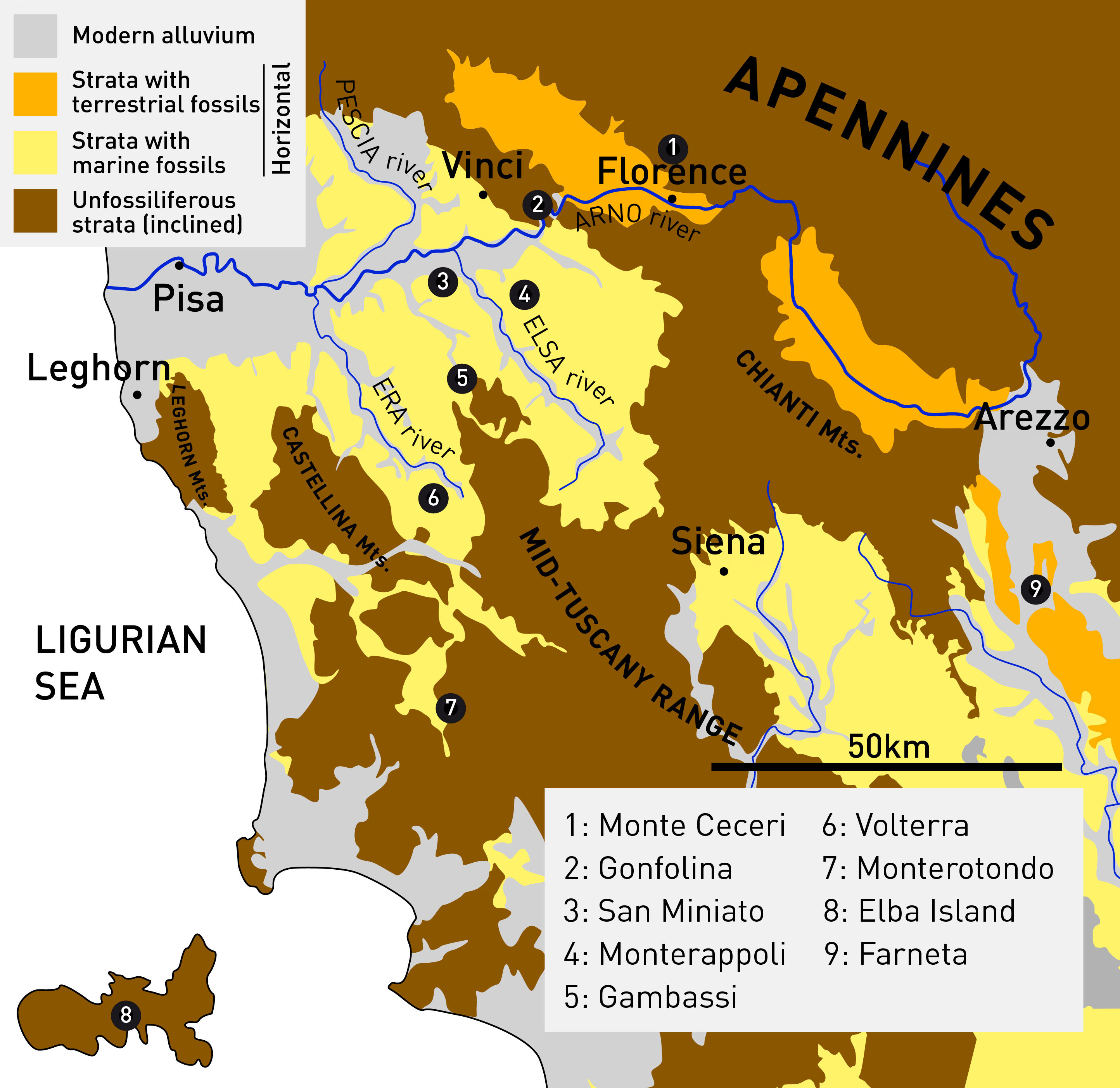
Fig. 1: A simplified geological map of Tuscany, showing more or less the structure of the region as it appeared to Steno in 1668, when he completed "De Solido intra Solidum Naturaliter Contento Dissertationis Prodromus": the oldest order of strata (brown colour, localities 1-2, 7-8) is formed by well-lithified and (largely) unfossiliferous rocks, all inclined with respect to the horizon (or otherwise without a recognisable geometric structure); a second order of rocks is formed by not well-cemented strata lying parallel to the horizon, rich with marine shelly fossils (light yellow, localities 3-6); a third order of horizontal strata is characterised by remains of large terrestrial animals, like elephants (orange, locality 9). To Steno, first-order rocks formed by deposition of a solid from waters and were originally horizontal; they lack fossils because life had not been created at the time of their formation. Then the sea retreated, then these strata were upturned from their original horizontality by collapse of some subterranean caves. Second order strata formed when the sea returned during the universal deluge, after God had created marine life: this is why they are richly fossiliferous. Some are slightly displaced from horizontality, but most are not. The third order dates to historical times: bones of elephant and other large terrestrial animal are those brought by Hannibal when fighting against the ancient Romans. Some action from subterranean vapours leads to formation of minerals and veins (localities 7-8). Steno was not aware that Leonardo da Vinci, one century and a half before him, had reconstructed a similar series of geological events without recurring to the hypothesis of a universal deluge. Leonardo’s manuscripts have been transcribed and published only in the late nineteenth and early twentieth century.
The Stenonian virtual journey through Tuscany unrolls in four stages, not necessarily to be followed in this order: 1) Macigno quarries, 2) Shell beds, 3) Vapours and Mines and 4) Elephant Bones. Nor the destinations proposed end the list of all the places actually visited by Steno during his residence in the region, in 1666-1668. This is the basic experience that allowed him to plan a general dissertation on "A Solid Contained in a Solid", including the first history of the Earth recontructed by studying "the Book of Nature".
1. Macigno quarries
Dante Alighieri mentions the word “macigno” in the XV Chant of the Inferno, when he encounters his former teacher, the important writer and political figure Brunetto Latini who had died in Florence in 1294, and when he is prophesied hard times caused by people from his own hometown.
“But that ungrateful and malignant race
which descended from the Fiesole of old,
and still have macigno and mountain in their blood,
will become, for your good deeds, your enemy”
“Macigno” (often translated simply as “rock” in English versions of the above passage) comes from the word “macinare”, meaning to grind, or mill. The word has been used for centuries to denote the sandstone that is quarried in the Fiesole hill, at Monte Ceceri (Figs. 1-2), explaining the sense in which it is used in reference to Fiesole in Dante’s verses.
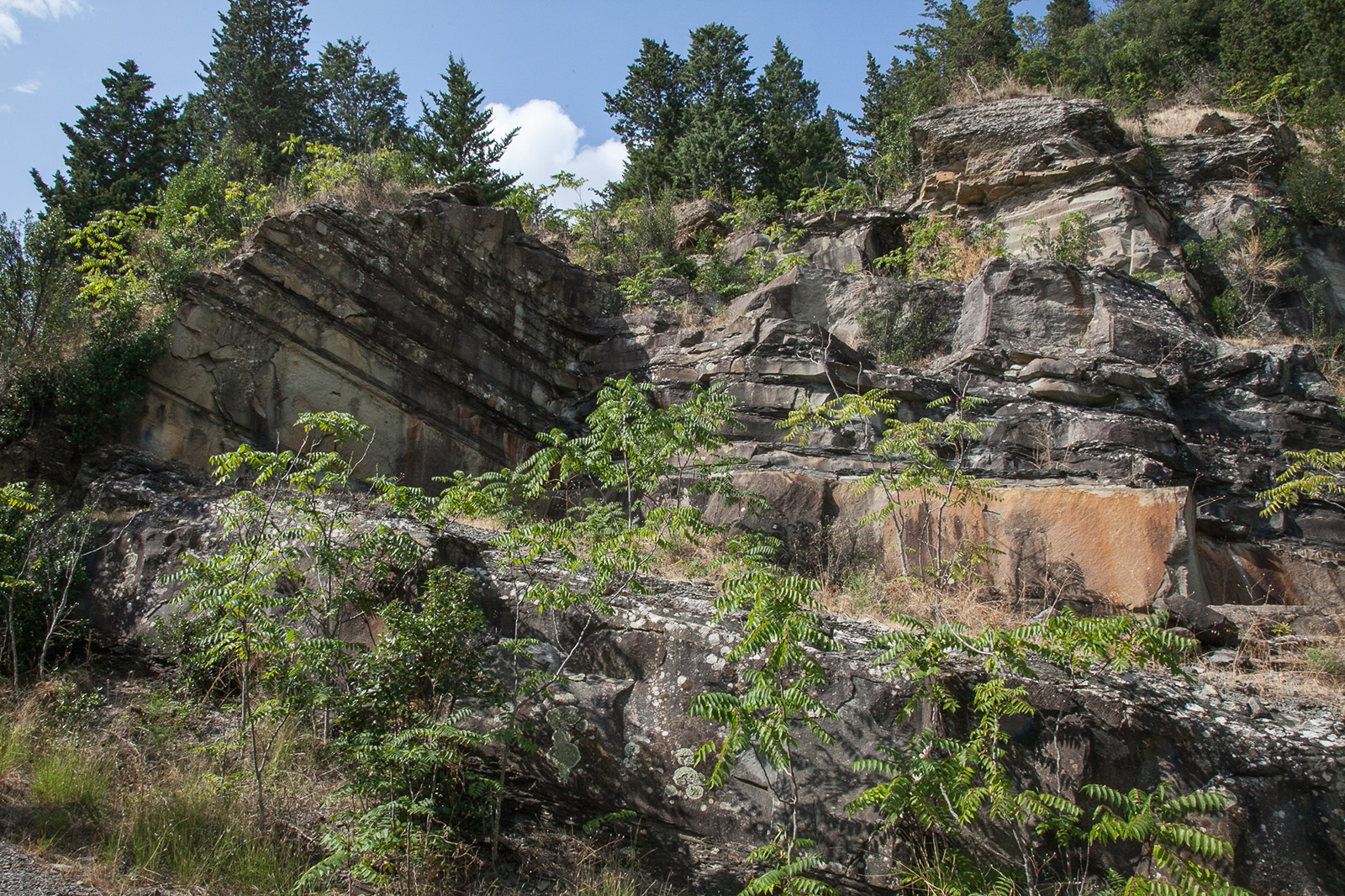
Fig. 2: Sandstone quarries at Monte Ceceri, Fiesole (locality 1 in fig. 1). This rock was called “macigno” by Dante Alighieri in 1300 (Inferno XV, 61-64).
A second historical location for quarrying “macigno” is at the Gonfolina canyon, cut by the Arno river (Fig. 3). This second location was particularly important, for the quarried stones could be easily transported by boat to Livorno and Pisa, where they were used as a building stones (Pietra serena). The locality is mentioned by Leonardo da Vinci in one of his unpublished manuscripts (1506-1508, CL f.9r):
“In places where the valleys are not filled with salty water, shells are never to be seen; as is plainly visible in the great valley of the Arno above Gonfolina, a rock formerly united to Monte Albano, in the form of a very high bank which kept the river pent up, in such a way that before it could flow into the sea, which was afterwards at its foot, it formed two great lakes; of which the first was where we now see the city of Florence together with Prato and Pistoia, and Monte Albano.”
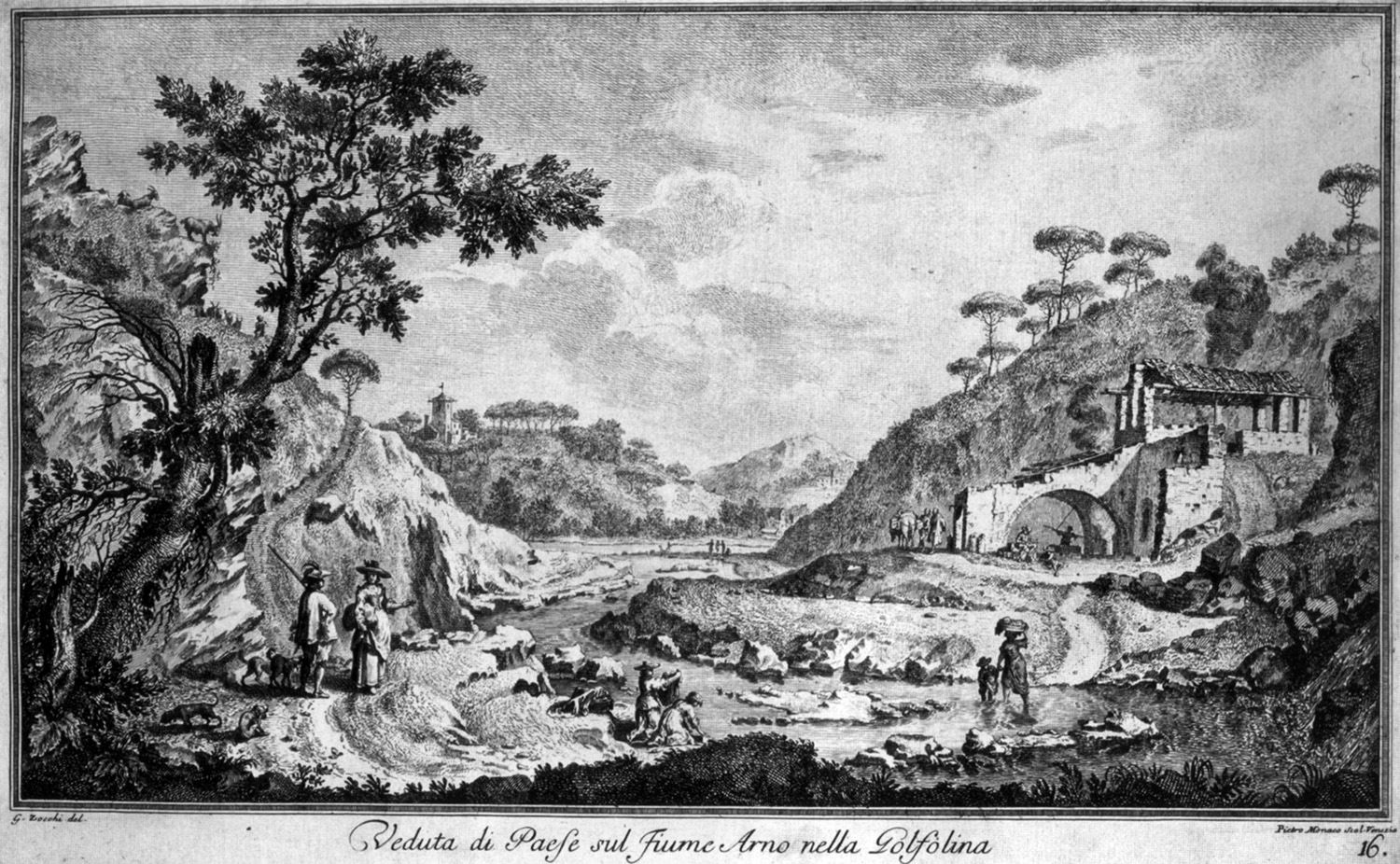
Fig. 2: The Gonfolina canyon, cut by the Arno river (locality 2 in fig. 1). The locality is mentioned by Leonardo da Vinci around 1506-1508 as the threshold between the upper and lower Arno valley. In Leonardo's reconstruction of the ancient tuscan landscape, the sea never surpassed this threshold, explaining why marine shelly fossils are never found upstream.
In a letter from Vienna, written in 27 October 1669 to Marcello Malpighi, in describing his geological experiences in Hungary (present day Slovakia), Steno uses the term “macigno” four times:
“My journey to visit the quarries caused me great happiness not just for the novelty of the observations, which were very few, but for the autopsy of those things, that upon reading metallic authors [i.e., Michele Mercati, author in 1593 of Metallotheca Vaticana, and Andrea Cesalpino, author of De Metallicis in 1596] are very hardly understood. I have seen nonetheless something consistent with my opinions on the transformations that the earth underwent, inasmuch that in the same places soils of macigno are inclined with respect to the horizon, so that in that place cannot have been materially made. Nor it can be doubted that gold and silver veins are just the filling of voids between macigno and macigno, and of cracks in those macigni [rocks].”
The word “macigno” was thus commonly used by Steno and his peers to describe a particular type of stratified rock, not just a rock. Steno could have visited the quarries at Monte Ceceri and Gonflina any time during his stay in Florence, and Gonfolina was on his way during the journey from Florence to Volterra of March 1668. The sedimentary formation outcropping at Monte Ceceri and Gonfolina is still called Macigno Formation: it lacks macrofossils and is formed by well-stratified tabular sandstones usually inclined with respect to the horizon, each formed by well-cemented grains of very fine sand (Fig. 3).
“If all particles in a stony stratum are observed to be of the same nature and of fine size, it cannot reasonably be denied that this stratum was produced at the time of Creation from a fluid that then covered all things; Descartes, too, accounts for the origin of the earth’s strata in this way. […] Differences in layers at the same place can be produced either by the diversity of particles leaving the fluid in succession, as this fluid is gradually dissipated more and more, or by different fluids being conveyed there at different times: so it happens that sometimes the same arrangement of layers is repeated in the same place, and often evident signs exist showing the ingress of new material (Prodromus: The strata of the earth).”
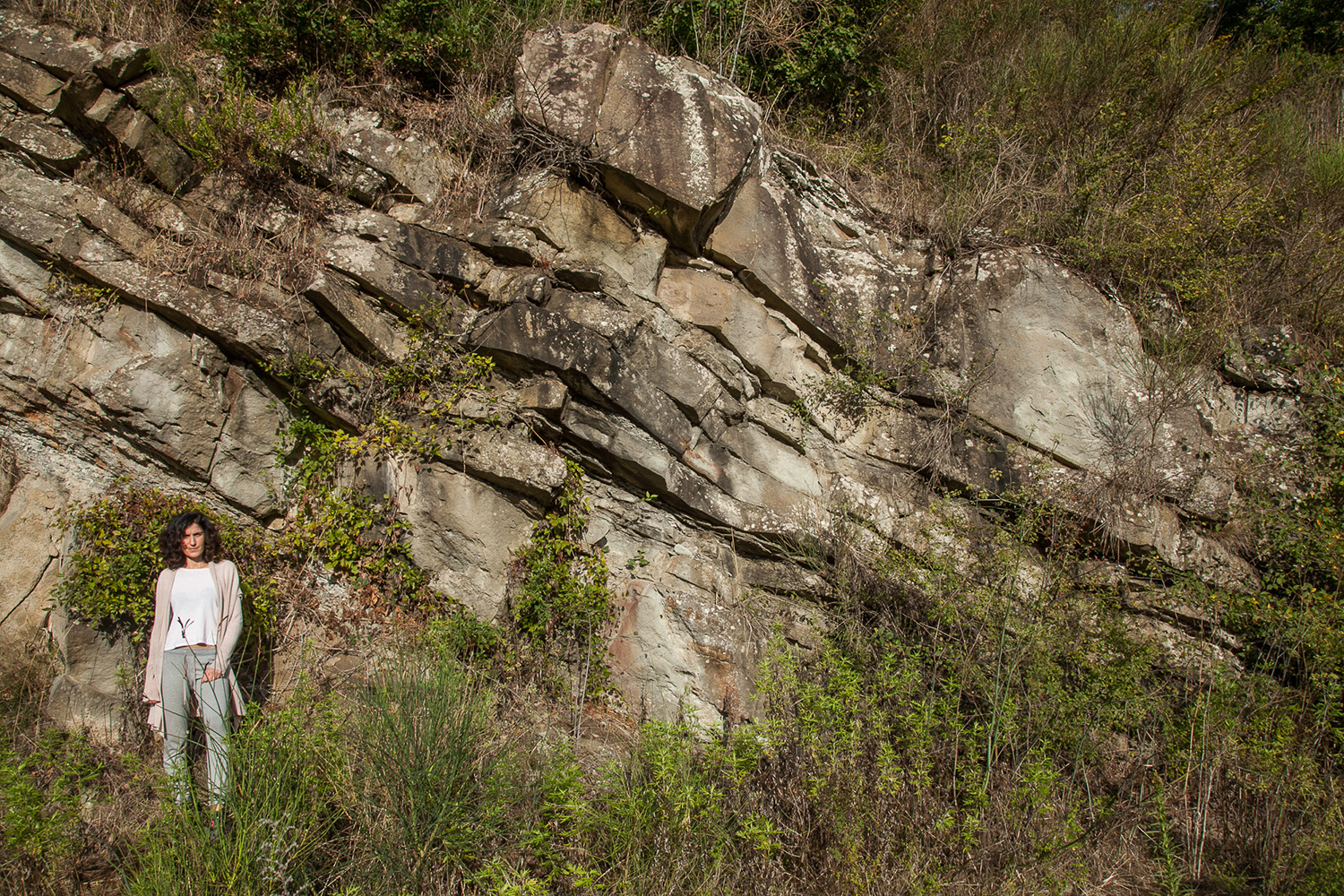
Fig. 3: Well-stratified sandstone strata, inclined with respect to the horizon, at one of the Gonfolina quarries on the left side of the Arno river, near Comeana (Macigno Formation, Oligocene; locality 2 in fig. 1). Sandstone partitions are regular, grain-size is homogeneous and no fossils can be seen with the naked eye.
These were the primordial strata, created when the earth was devoid of any form of life, formed after deposition of a solid fraction from a universal ocean (a fluid) and horiginally horizontal. The change in direction of the strata was to be attributed to the collapse of large cavities present within the body of the earth.
2. Shell beds
During the journey that in the late spring-early summer of 1668 took Steno from Florence to the Elba island, after stopping for a month near Volterra (reconstructed by Gustav Scherz, in Kardel and Maquet, 2013), he had plenty occasions to see fossiliferous strata. These are the same strata mentioned in the unpublished passage from Leonardo quoted above. The best guide to find the proper places would have been Michele Mercati’s Metallotheca Vaticana, yet unpublished at his time, but available in manuscript and with beautiful engravings thanks to the generosity of Carlo Dati. Mercati writes about and illustrates fossils (figs. 4-5) collected in the hills around his hometown, San Miniato al Tedesco (locality 3 in fig. 1), about 25 miles West of Gonfolina.
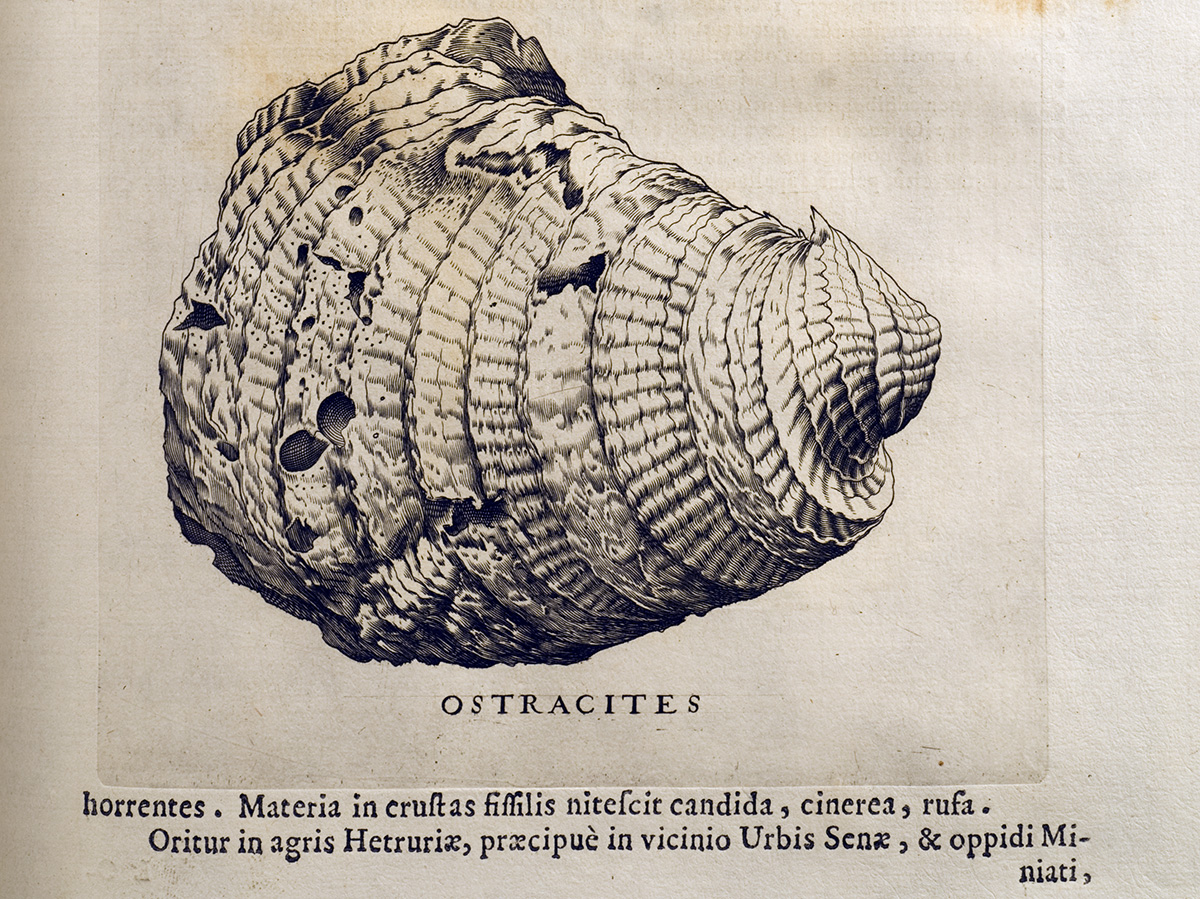
Fig. 4: Engraving from Metallotheca Vaticana by Michele Mercati. The incision and manuscript were prepared before the death of Michele Mercati in 1593 (unpublished until 1717, but available to Steno during his stay in Florence): “Ostreacites” can be translated today as “fossil oyster”. The inscription at the foot of the page reveals that these fossils were frequently found near Siena and San Miniato (Mercati’s hometown).
Thanks to the comparison between shells dug up from the earth and modern shells — brought to him by Leghorn fishermen and carefully studied with an experience on all kinds of animals (insects, fishes, mammals), Steno could positively recognise similarity in growth, thence the organic nature of all fossils.
“The inner surface of the shell itself is identical to the inner surface of the inmost or largest lamina, but the outer surface is composed of the outer surface of the smallest lamina and the surface of all edges of the intermediate laminae. […] There are shells of oysters, of remarkable size, in which are found several oblong worm-eaten cavities.” (compare this description with Michele Mercati's engraving of Ostreacites in Fig. 4)
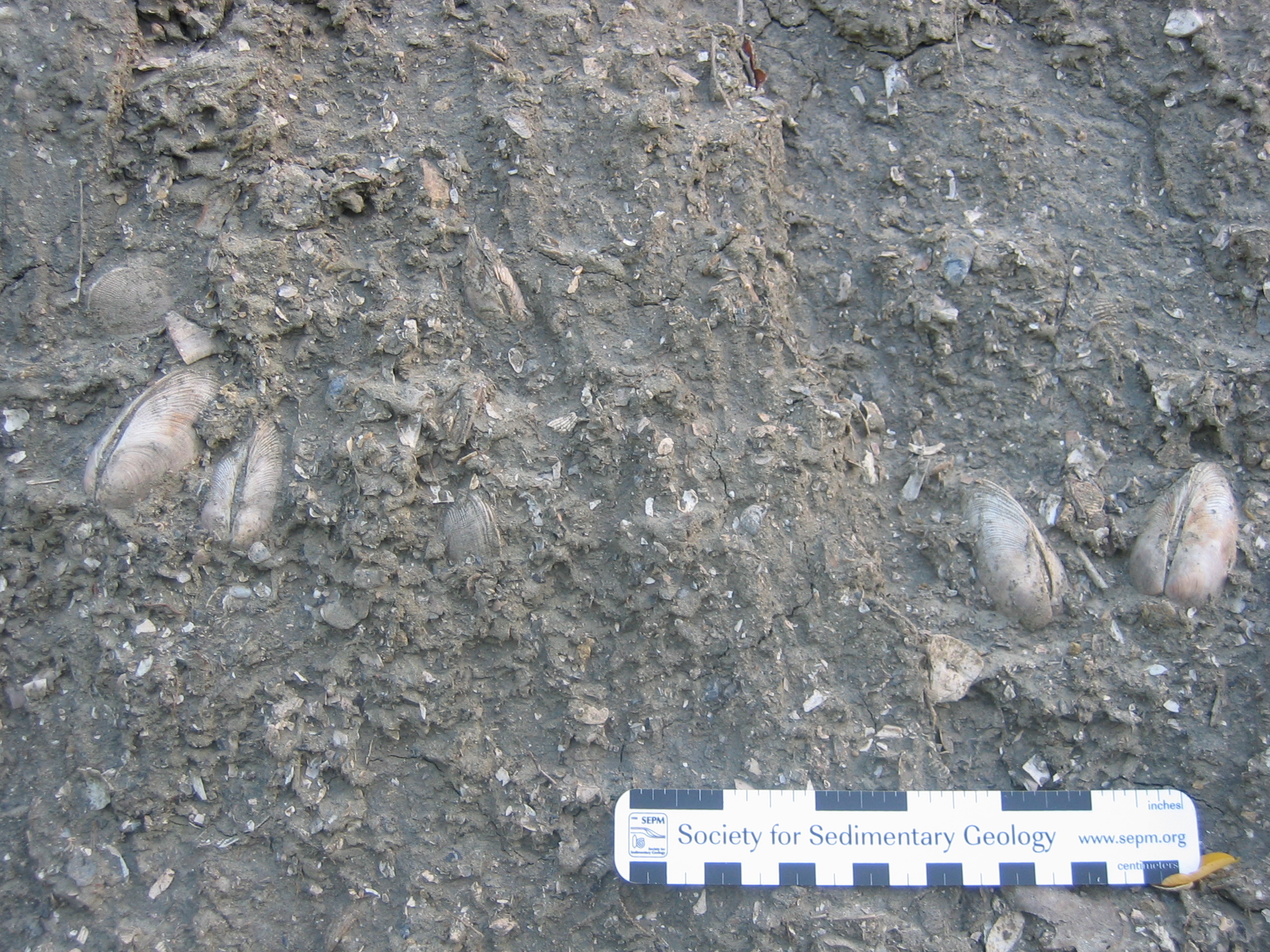
Fig. 6: Shell bed in the San Miniato hill (locality 3 in fig. 1).
Shelly fossils are frequent at many locations of the valleys of the river Arno and its affluents, such as the Elsa and Era rivers (e.g., at Monterappoli, locality 4 in fig. 1). It is however at Volterra that Steno finds the best place to convince his readers that earth’s history can be uncovered by use of geometric relationships. Prerequisites were the principles of Original Horizontality, Original Continuity, and Superposition of Individual Strata, enunciated in the opening sections of the Prodromus. Fossiliferous strata of the Volterra hills are horizontal (Fig. 7, locality 6 in fig. 1), and must be younger than the inclined and folded strata of the Tuscan mountains on which they geometrically terminate. Volterra is one of the very few localities mentioned in the Prodromus. Together with evidences coming from many other hills of Tuscany (in yellow in Fig. 1). it revealed how the sea had invaded the region during the universal deluge, after life had been created and for this reason full of the remains of fishes, molluscs and other marine animals. It also showed that the sea retreated before Noha's descendants, the Etruscans, used blocks cut from those very strata to build the walls of their towns. It was, again, “how well then everything fits together! How unanimously they come together in agreement” (see Conjecture 5 in Canis Carchariae Dissectum Caput of 1667).
“Shellfish of every kind are found in the huge stones that are found in certain places there (the remains of the oldest walls), and not so very long ago a stone filled with striated shellfish was hewn from the middle of the forum; and so it is certain that shellfish found today in the said stones were already produced at the time when the walls of Volterra were erected. And lest some say that only shells, converted to stone, or enclosed by stone, have suffered no damage from the gnawing of time, the whole hill on which the oldest of the Etruscan cities is built rises from marine sediments, laid on top of other, parallel to the horizon, in which there are many non-stony strata which abound in true molluscs that have suffered no change in any way, and so it is possible to say with certainty that the unchanged molluscs that are extracted from them today were produced more than 3000 years ago. From the founding of the city to the present day we reckon more than 2420 years have elapsed; and who will not grant that many centuries have elapsed since the first men transferred their homes there until it grew to the size that flourished at the time of the founding of the city? If we add to these centuries the time which elapsed between the laying down of the first sediment of the hill of Volterra and the withdrawal of the sea from the same hill, when strangers flocked to it, we shall easily go back to the time of the universal deluge”. (Prodromus: Other parts of animals)
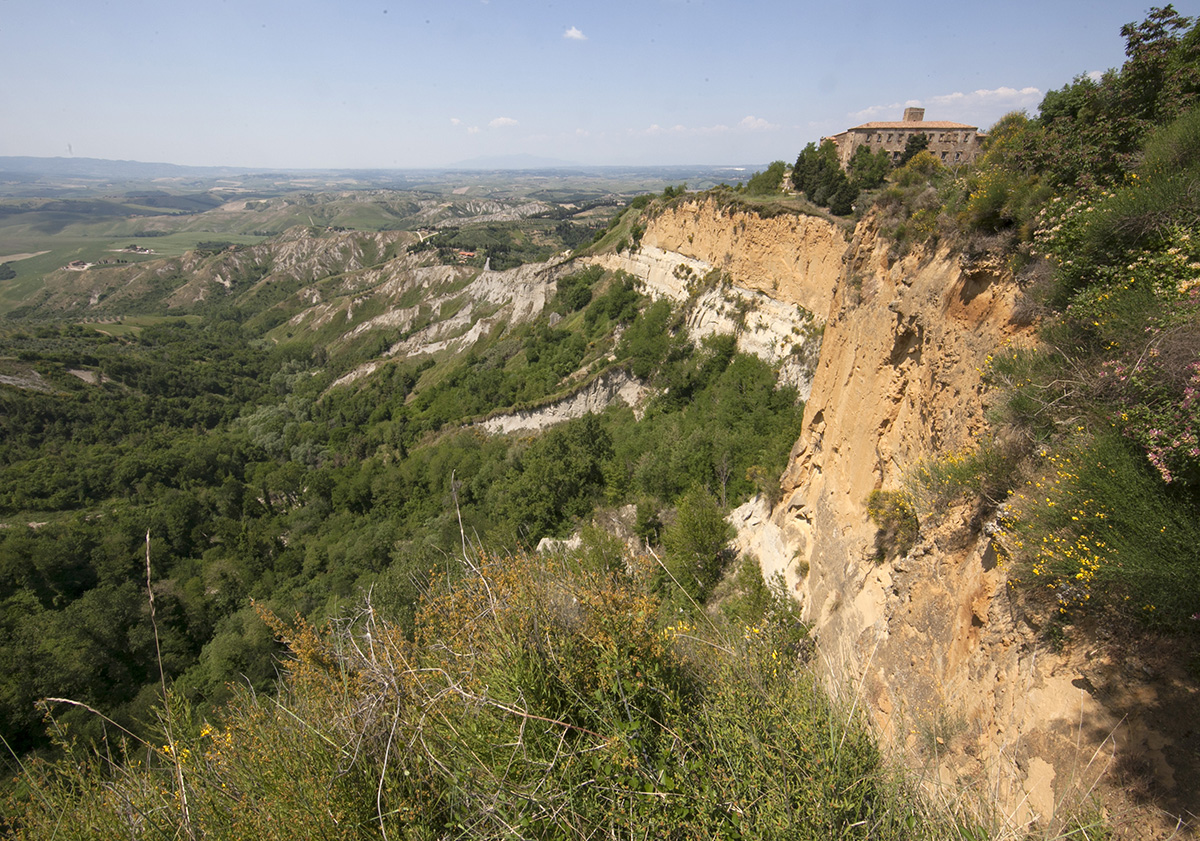
Fig. 7: View of the Tuscan landscape from the “cliffs” (“balze”) of Volterra, a town founded by the Etruscans (locality 6 in fig. 1): from here Steno could find the concluding evidence that all fossiliferous strata were horizontal and predated the oldest known human settlements (the etruscans'), connecting history as revealed by the “Book of Nature” with history narrated in the “Book of Scripture”.
It is interesting to note that San Miniato and Volterra offered the same view and the same epiphanic effect to Giambattista Brocchi, from Bassano del Grappa, in 1811. Brocchi was the first geologist in the modern sense — shunning “theories of the earth” and aiming at the reconstruction of regional geohistory within a deep-time set of mind — to assign these strata to the “Tertiary”, a concept brought to worldwide use thanks to his “Conchiologia Fossile Subappenina” of 1814.
“I determined the northern boundary of this ancient seafloor upon a high point at San Miniato, whereas from the bell tower of the Volterra Cathedral I recognised its southern limit.” (Brocchi’s travel diary, 1811)
Brocchi was also the first historian of geology to recognise the importance of Steno’s demonstration of the organic origin of fossils, translated for the wider English-reading public by Charles Lyell, in the first volume of the “Principles of Geology” (1830). And it was Alexander Von Humboldt, in 1823 (“Essai géognostique”), who first wrote about Steno’s geometric demonstration of the stratigraphic relationships between Tuscan sedimentary units, in a book for geologists of the modern type (Charles Darwin, to name one).
3. Vapours and mines
In southern Tuscany Steno could also visit places where to make experiences about heat and vapour emitted from the ground and mines where large and small crystals were dug, offering the means to study in what natural conditions crystalline solids form. We know that he stayed for a few days at Libbiano, about 20 miles south of Volterra, within an area known since centuries for iron and copper deposits (“Colline Metallifere”, or Metal Hills), vapour emitted from stone cracks, concretions of various colours and materials and warm (e.g. Gambassi Terme, locality 5 in fig. 1) and boiling water flowing from the ground (e.g., Monterotondo, locality 7 in fig. 1, and Larderello, Fig. 8).
“The majority of the minerals with which human effort is engaged did not exist from the beginning of things […] it is more than probable that all the minerals filling either the clefts or wide spaces in the rocks obtained their material from vapour forced out from the rocks themselves.” (Prodromus: The origin of variegated stones and repositories of minerals)
In southern Tuscany Steno would have visited mines of the Elba island (locality 8 in fig. 1), famous in antiquity for the abundance of ore fields important to ancient Etruscans, as of the end of the Iron Age, and where the Grand Duchy had built towns and processing plants to systematically exploit mines.
“[…] Angular bodies that occur frequently in the dendrites of Elba, such as form only in a free fluid. But what is the need for other proof when experience itself speaks? I have examined various moist places, some exposed to the light, some underground […].” (Prodromus: Plants)
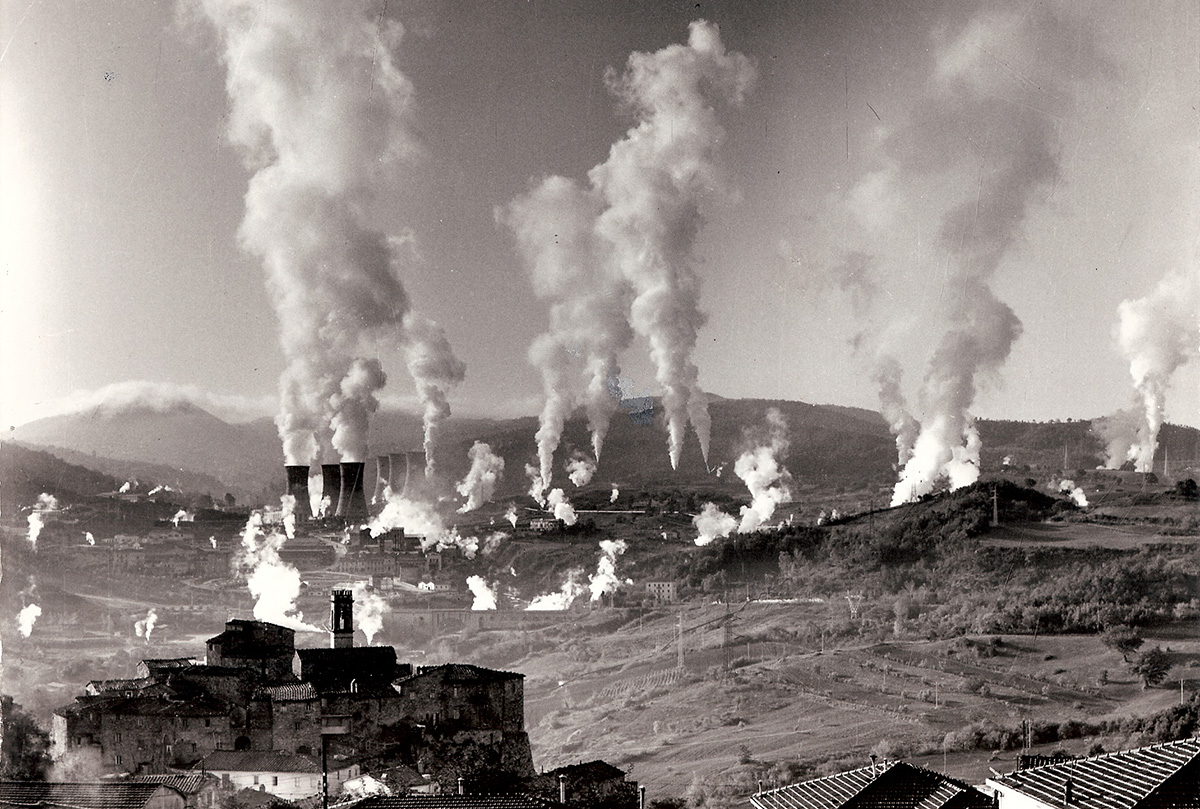
Fig. 8: Vapours emitted near Larderello (near Monterotondo, locality 7 in fig. 1).
4. Elephant bones
In 1669 Steno first brought to the public attention the (fossil) bones of “elephants” (in fact mammoths: Fig. 9) and other large terrestrial mammals dug up from sedimentary basins of the inner Apennines, as the Chiana Basin south of Arezzo (e.g., Farneta; locality 9 in fig. 1).
“Huge bones that are dug from the fields of Arezzo […] the skulls of pack animals found there are not of animals of this climate, as neither are the huge femurs and very long scapulae found in the same plain […] built up from various strata that are filled with stones rolled down from the surrounding mountains by the force of torrents.” (Prodromus: Other parts of animals)
Efforts had been made to understand the origin of these large animals in Africa, thanks to connections of fellows of the Cimento Academy, such as Giovanni Alfonso Borelli who was active in Sicily:
“I’m honoured by the letter of Your Highness with the drawing of a buffalo skull, or an ox, found in the Chiane [a valley extending South of locality 9 in Fig. 1], and it is really by far larger than those found in Italy nowadays. If this came from Africa I cannot tell, since I’m told that oxen of such an enormous size are not found in Barbaria [i.e., Africa]. Maybe that race of a size larger than our homegrown lived in Italy at that time, much like the found dogs and horses that by far exceed others.” (Giovanni Alfonso Borelli to Leopoldo de’ Medici, December 1667, referring also to bones of carnivores and equids)
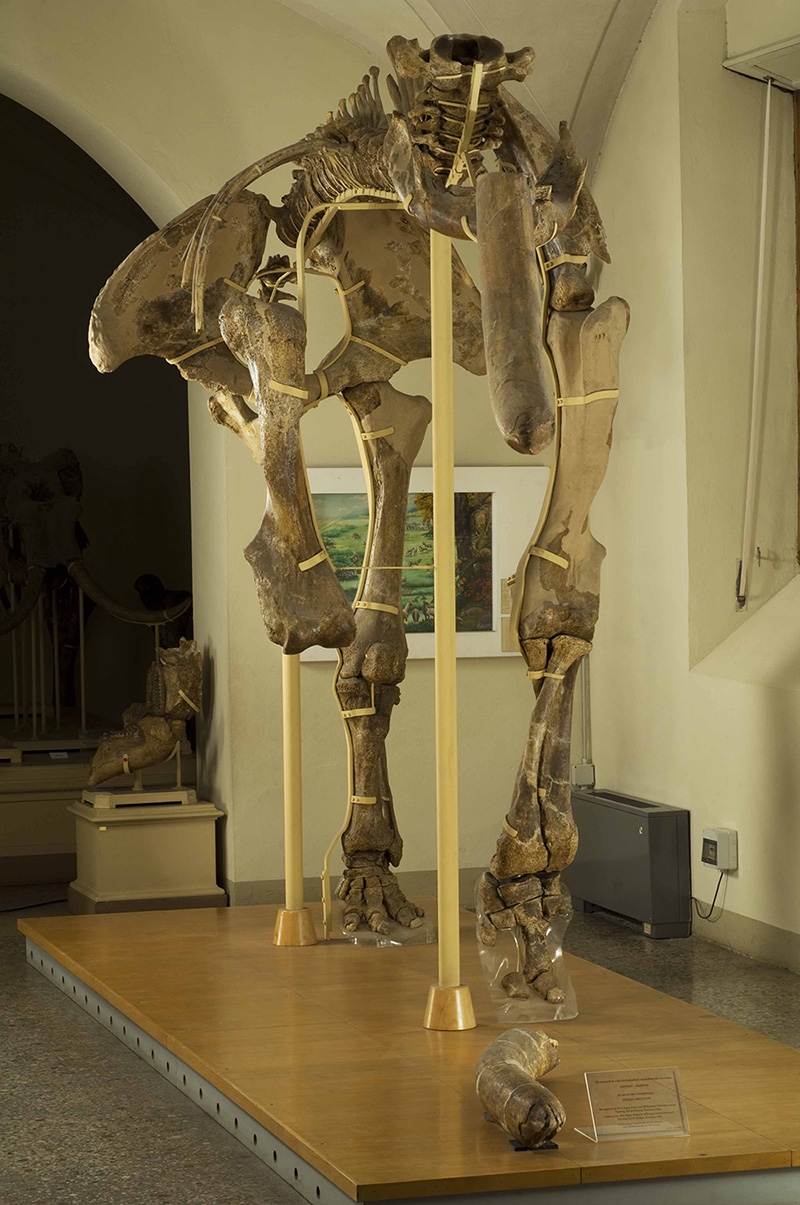
Fig. 9: Southern mammoth (Mammuthus meridionalis) from Farneta, south of Arezzo (locality 9 in fig. 1), specimen in exhibition at the Museo di Geologia e Paleontologia, Università di Firenze.


